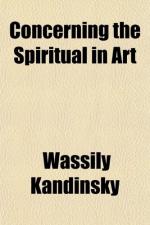How many years will it be before a greater segment of the triangle reaches the spot where he once stood alone? Despite memorials and statues, are they really many who have risen to his level? [Footnote 2: Are not many monuments in themselves answers to that question?]
In every segment of the triangle are artists. Each one of them who can see beyond the limits of his segment is a prophet to those about him, and helps the advance of the obstinate whole. But those who are blind, or those who retard the movement of the triangle for baser reasons, are fully understood by their fellows and acclaimed for their genius. The greater the segment (which is the same as saying the lower it lies in the triangle) so the greater the number who understand the words of the artist. Every segment hungers consciously or, much more often, unconsciously for their corresponding spiritual food. This food is offered by the artists, and for this food the segment immediately below will tomorrow be stretching out eager hands.
This simile of the triangle cannot be said to express every aspect of the spiritual life. For instance, there is never an absolute shadow-side to the picture, never a piece of unrelieved gloom. Even too often it happens that one level of spiritual food suffices for the nourishment of those who are already in a higher segment. But for them this food is poison; in small quantities it depresses their souls gradually into a lower segment; in large quantities it hurls them suddenly into the depths ever lower and lower. Sienkiewicz, in one of his novels, compares the spiritual life to swimming; for the man who does not strive tirelessly, who does not fight continually against sinking, will mentally and morally go under. In this strait a man’s talent (again in the biblical sense) becomes a curse—and not only the talent of the artist, but also of those who eat this poisoned food. The artist uses his strength to flatter his lower needs; in an ostensibly artistic form he presents what is impure, draws the weaker elements to him, mixes them with evil, betrays men and helps them to betray themselves, while they convince themselves and others that they are spiritually thirsty, and that from this pure spring they may quench their thirst. Such art does not help the forward movement, but hinders it, dragging back those who are striving to press onward, and spreading pestilence abroad.
Such periods, during which art has no noble champion, during which the true spiritual food is wanting, are periods of retrogression in the spiritual world. Ceaselessly souls fall from the higher to the lower segments of the triangle, and the whole seems motionless, or even to move down and backwards. Men attribute to these blind and dumb periods a special value, for they judge them by outward results, thinking only of material well-being. They hail some technical advance, which can help nothing but the body, as a great achievement. Real spiritual gains are at best under-valued, at worst entirely ignored.




